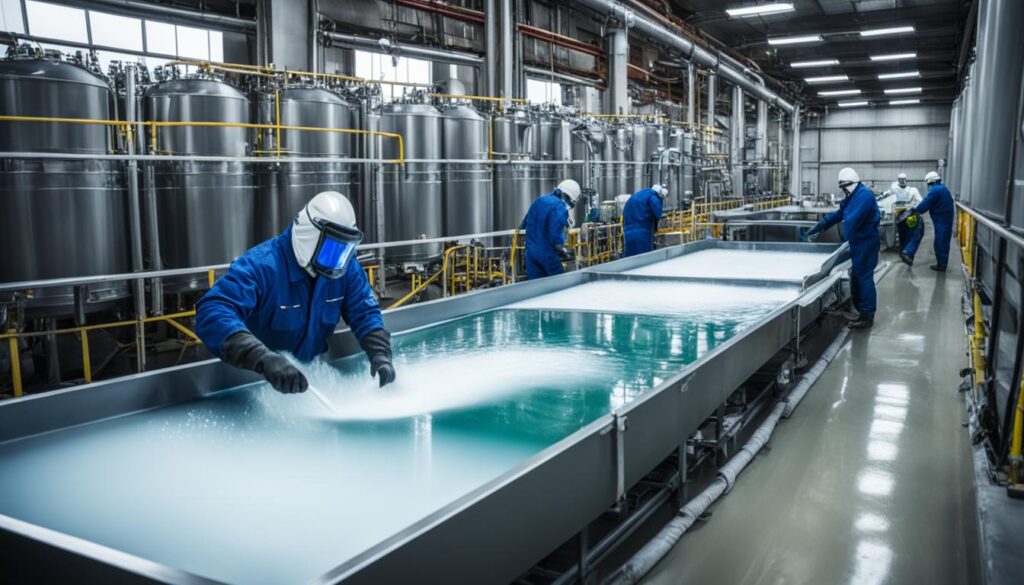In this article, I will explore the benefits and potential risks associated with potassium hydroxide. Widely used in a variety of industries, potassium hydroxide has gained attention for its versatile applications. However, it is crucial to understand the potential harms and safety precautions associated with its use.
Key Takeaways:
- Potassium hydroxide has various applications in manufacturing, industrial, medical, and chemical sectors.
- It is used as an electrolytic solution, pesticide, food thickener, stabilizer, and more.
- Proper safety measures and professional guidance should be followed when dealing with potassium hydroxide.
- Consult a healthcare professional before using potassium hydroxide or products containing it during pregnancy.
- Potassium hydroxide can cause skin and eye damage if not handled with caution.
Industrial Uses of Potassium Hydroxide
Industries rely on the versatility of potassium hydroxide for a wide range of applications. Here are some of the key uses and advantages of potassium hydroxide in various industrial sectors:
- Plating: Potassium hydroxide is commonly used in electroplating processes to enhance the adhesion and durability of metal coatings, providing a smooth and polished surface finish.
- Alkaline Batteries: The production of alkaline batteries involves the use of potassium hydroxide as an electrolyte, enabling the transfer of ions between the battery’s electrodes to generate electric current.
- Pesticides: Potassium hydroxide is an essential component in the formulation of pesticides, contributing to their effectiveness in pest control by disrupting the physiological functions of insects and pests.
- Food Additive: In the food industry, potassium hydroxide serves as a food additive, functioning as a pH regulator, thickener, stabilizer, and controller. It improves the texture and appearance of various food products.
- Chemical Manufacturing: Potassium hydroxide is vital for the production of various chemicals, including detergents, liquid soaps, biodiesel, liquid fertilizers, pharmaceuticals, and synthetic fibers.
The inherent properties of potassium hydroxide make it an essential resource for numerous industrial processes, contributing to the production of high-quality products and ensuring efficient operations.
Advantages of Potassium Hydroxide in Industrial Applications
The use of potassium hydroxide in industries offers several advantages:
- Versatility: Potassium hydroxide exhibits excellent solubility, allowing for easy integration into a wide range of industrial processes and formulations.
- Effective pH Control: As a strong base, potassium hydroxide enables precise pH adjustment, ensuring optimal conditions for chemical reactions and product stability.
- Enhanced Product Performance: The addition of potassium hydroxide can improve the performance and longevity of various products, such as batteries, plating coatings, and pesticides, enhancing their functionality and effectiveness.
- Improved Product Appearance: In the food industry, the use of potassium hydroxide as a food additive helps to achieve desirable textures, thickness, and appearance in processed food products. It also aids in preventing spoilage and extending shelf life.
- Cost-Effectiveness: Potassium hydroxide is a cost-effective solution for multiple industrial applications, offering a favorable balance between performance benefits and affordability.
With its wide range of uses and advantageous properties, potassium hydroxide continues to play a crucial role in enhancing industrial processes, product quality, and overall efficiency.
Potassium Hydroxide in Health and Wellness
Potassium hydroxide, commonly known as KOH, has various applications in the health and wellness industry. It is utilized for its unique properties in the medical field, skincare products, and the production of facial cleansers and liquid soaps.
One of the significant uses of potassium hydroxide in health is its effectiveness in treating warts. Potassium hydroxide is applied topically to warts, where it helps to remove the dead skin cells and promote the healing process. This treatment option has been proven to be safe and efficient under medical supervision.
“Potassium hydroxide is a valuable ingredient in facial cleansers and liquid soaps due to its cleaning and alkalizing properties,” says Dr. Sarah Adams, a dermatologist.
In addition to treating warts, potassium hydroxide is used in skincare products for babies. Its mild and water-soluble properties make it suitable for delicate and sensitive baby skin. It is commonly found in baby bath products and moisturizers, where it helps to cleanse and moisturize the skin without causing any irritation.
The Power of Potassium Hydroxide in Facial Cleansers
Potassium hydroxide plays a vital role in the production of facial cleansers. As a cleaning agent, it effectively removes dirt, oil, and impurities from the skin, leaving it clean and fresh. Its alkalizing properties help to balance the skin’s pH level, which is essential for maintaining healthy and radiant skin.
Facial cleansers containing potassium hydroxide are especially beneficial for individuals with oily or acne-prone skin. The deep-cleansing action helps to unclog pores and reduce excess oil, leading to clearer and smoother skin. It is important to note that facial cleansers with potassium hydroxide should be used as directed and in moderation to avoid any potential side effects.
Overall, potassium hydroxide plays a significant role in the health and wellness industry. Its unique properties and applications make it a valuable ingredient in various products, from medical treatments to skincare and facial cleansers.
| Potassium Hydroxide in Health and Wellness |
|---|
| Treats warts effectively |
| Gentle and water-soluble for baby skincare products |
| Essential ingredient in facial cleansers |
| Deep-cleansing action for oily and acne-prone skin |
| Helps maintain a healthy and radiant complexion |

Potassium Hydroxide during Pregnancy
When it comes to the consumption of potassium hydroxide or products containing it during pregnancy, seeking guidance from a healthcare professional is vital. The safety of any medication or substance during pregnancy should always be a priority.
Potassium hydroxide, commonly used in various industries and applications, has minimal systemic absorption. However, it is essential to exercise caution and gather expert advice to ensure the well-being of the mother and developing fetus.
During pregnancy, there are numerous physiological changes that can affect the body’s response to certain substances. Although the absorption of potassium hydroxide is typically limited, it is crucial to consider potential risks associated with its use.
Consulting a healthcare professional will help determine the appropriate course of action and ensure the safety of both the mother and the baby.
It is important to note that individual circumstances may vary, and the healthcare provider will consider factors such as the specific product, dosage, duration of use, and the overall health of the pregnant individual.
Experts recommend avoiding unnecessary risks during pregnancy, which includes evaluating the usage of potassium hydroxide and related products.
Remember, before using any medication or substance during pregnancy, always consult with a healthcare professional to ensure the safety and well-being of both the expectant mother and the developing baby.
Mechanism of Action of Potassium Hydroxide in the Body
When it comes to the effects of potassium hydroxide on the body, understanding its mechanism of action is essential. Potassium hydroxide, a strong base, can cause damage to the skin through various processes.
- Degreasing: Potassium hydroxide has the ability to dissolve fats and oils present on the skin’s surface, resulting in degreasing.
- Water extraction: By extracting water from the skin cells, potassium hydroxide can disrupt the moisture balance, leading to drying and irritation.
- Protein dissolution: This strong base can also dissolve proteins, potentially damaging the skin’s structural integrity and causing further irritation.
It is important to handle potassium hydroxide with caution to avoid adverse effects on the skin, eyes, and gastrointestinal tissues. Improper handling can result in tissue damage and should be avoided at all costs.
Potassium Hydroxide Effects on Skin:
“The strong base properties of potassium hydroxide can have detrimental effects on the skin, including degreasing, water extraction, and protein dissolution.”
These effects can lead to skin dryness, irritation, and potential damage if not properly addressed. Safety precautions and proper handling techniques are crucial when working with potassium hydroxide.
Note: This image visually represents the potential effects of potassium hydroxide on the skin.
Harms of Potassium Hydroxide
Potassium hydroxide, when inhaled or consumed in large quantities, can cause irritation, fluid accumulation in the lungs, vomiting, and nausea. It can also lead to severe burns and tissue damage if it comes into contact with the skin or eyes. Proper safety measures should be followed when dealing with potassium hydroxide.
| Harms of Potassium Hydroxide | Symptoms |
|---|---|
| Irritation | Redness, itching, and discomfort |
| Fluid accumulation in the lungs | Coughing, shortness of breath, and respiratory distress |
| Vomiting | Forceful expulsion of stomach contents |
| Nausea | Feeling of discomfort in the stomach |
| Severe burns | Destruction of skin tissue resulting in pain, blistering, and scarring |
| Tissue damage | Cellular destruction and potential long-term effects |
It is important to handle potassium hydroxide with care and take appropriate precautions to prevent harm and ensure personal safety.
Safety Tips when Dealing with Potassium Hydroxide:
- Always wear protective gloves, goggles, and clothing when working with potassium hydroxide.
- Work in a well-ventilated area to minimize inhalation of fumes.
- Keep potassium hydroxide away from sources of heat and moisture.
- Handle containers containing potassium hydroxide with caution to prevent spills or leaks.
- In case of skin contact, immediately rinse the affected area with water and seek medical attention if necessary.
- If potassium hydroxide comes into contact with the eyes, flush them with water for at least 15 minutes and seek immediate medical attention.
- Store potassium hydroxide in a secure location, out of reach of children and unauthorized individuals.
Potassium Hydroxide in Agriculture
Potassium hydroxide is a valuable resource in the field of agriculture, providing numerous benefits for crop health and growth. As a highly soluble fertilizer with a low salt index, potassium hydroxide plays a crucial role in enhancing the overall health and productivity of crops.
One of the key advantages of using potassium hydroxide in agriculture is its ability to strengthen the root systems of plants. This promotes better nutrient uptake and absorption, resulting in healthier and more robust crops. Additionally, potassium hydroxide has been found to improve disease resistance in plants, making them less susceptible to common agricultural infections.
The application of potassium hydroxide in agriculture has also been linked to increased crop yields. By providing plants with essential nutrients, it helps optimize their growth potential and maximize the quantity and quality of harvested produce. Moreover, potassium hydroxide enhances the drought tolerance of crops, enabling them to withstand water scarcity and environmental stressors.
When using potassium hydroxide as a fertilizer, it is important to follow recommended application rates and guidelines to prevent any potential negative impact on the environment. Proper handling and disposal methods are essential to ensure minimal ecological disruption.
Overall, potassium hydroxide serves as a valuable tool for farmers and agriculturalists, contributing to the maintenance and improvement of crop health. Its role in strengthening roots, enhancing disease resistance, increasing crop yields, and improving drought tolerance makes it an indispensable resource in the world of agriculture.
Benefits of Potassium Hydroxide in Agriculture:
- Enhances root systems
- Improves disease resistance
- Increases crop yields
- Enhances drought tolerance
| Benefit | Description |
|---|---|
| Enhances root systems | Strengthens plant roots, promoting better nutrient uptake and absorption. |
| Improves disease resistance | Increases plants’ ability to resist and combat common agricultural infections. |
| Increases crop yields | Optimizes plant growth potential, resulting in higher quantities and quality of harvested produce. |
| Enhances drought tolerance | Helps crops withstand water scarcity and environmental stressors. |

Potassium Hydroxide in Food Processing
When it comes to processed foods, potassium hydroxide plays a crucial role as a food additive. Its stabilizing properties make it a popular choice for extending the shelf-life of various food products. Additionally, potassium hydroxide acts as a thickener, enhancing the texture and consistency of processed foods.
One of the key areas where potassium hydroxide is utilized in food processing is in the production of chocolate and cocoa. It helps in the alkalization process, which influences the flavor, color, and texture of chocolate. Potassium hydroxide is also involved in the glazing of pretzels, providing the characteristic glossy appearance and enhancing their overall appeal.
By incorporating potassium hydroxide into food processing, manufacturers can improve the stability and quality of their products. Moreover, it allows for greater control over the production process, resulting in consistent and desirable outcomes.
Potassium Hydroxide in Other Industries
Potassium hydroxide (KOH) is a versatile compound that finds applications in various industries, showcasing its significance and wide-ranging capabilities. Let’s explore how potassium hydroxide is utilized in different sectors:
Cosmetics
Potassium hydroxide is commonly used in the cosmetics industry due to its alkaline properties. It acts as an emulsifying agent and stabilizer in creams, lotions, and other skincare products. The presence of potassium hydroxide helps to maintain the pH balance and improve the texture of cosmetic formulations.
Pharmaceuticals
In pharmaceutical manufacturing, potassium hydroxide plays a crucial role as a pH regulator and a component in various medications. It is used in the production of medicines, ointments, and creams, where its alkaline nature aids in formulation and stabilization processes.
Soaps and Detergents
Potassium hydroxide is a key ingredient in the production of liquid soaps and detergents. Its strong alkaline properties help break down oils, fats, and dirt, making it effective in cleaning applications. Potassium hydroxide contributes to the foaming and cleaning capabilities of these products.
Photography
In photography, potassium hydroxide is used in the development of photosensitive materials. It plays a vital role in the development of black and white photographs by acting as a chemical developer that enhances image visibility and clarity.
Oil Industry
The oil industry utilizes potassium hydroxide in various processes, such as refining and cleaning equipment. It helps to neutralize acidic components and remove impurities, ensuring the smooth operation of oil extraction and processing operations.
Batteries and Super Absorbent Polymers
Potassium hydroxide is an essential component in the production of alkaline batteries. It acts as an electrolyte, facilitating the flow of ions between the battery’s electrodes. Additionally, potassium hydroxide is used in the production of super absorbent polymers, which find applications in diapers, agricultural products, and other absorbent materials.
Overall, the diverse applications of potassium hydroxide in industries such as cosmetics, pharmaceuticals, soaps and detergents, photography, oil, batteries, and super absorbent polymers highlight its versatility and crucial role in various manufacturing processes.

Potassium Hydroxide in Environmental Hazards
Potassium hydroxide poses significant environmental hazards, particularly to aquatic organisms. When released into water bodies, it can have long-term detrimental effects on aquatic animals and ecosystems. Proper disposal and careful handling of potassium hydroxide are essential in order to mitigate the potential environmental risks it presents.
The toxic nature of potassium hydroxide can have severe consequences for aquatic life. When exposed to this compound, aquatic organisms may experience physiological and behavioral changes, reduced reproduction rates, and even death. These adverse effects can disrupt the delicate balance of aquatic ecosystems, leading to cascading impacts on biodiversity and ecosystem services.
Due to its high alkaline properties, potassium hydroxide can raise the pH of water bodies, causing shifts in the aquatic environment’s chemical composition. This alteration can further exacerbate the impact on aquatic life, particularly those organisms that are sensitive to changes in pH levels.
Furthermore, improper disposal of potassium hydroxide can contaminate groundwater and surface water, potentially polluting drinking water sources and further threatening human health and the environment. It is crucial to follow proper disposal regulations and guidelines to prevent the release of potassium hydroxide into the environment.
Implementing best practices in the handling and storage of potassium hydroxide is vital to minimize its environmental hazards. This includes storing it in secure containers, avoiding spills or leaks, and ensuring effective containment measures. Additionally, individuals working with potassium hydroxide should be properly trained on its safe handling and disposal procedures.
Potassium Hydroxide Environmental Hazards: Key Points
- Potassium hydroxide is toxic to aquatic organisms and can have long-term effects on aquatic ecosystems.
- Improper disposal of potassium hydroxide can lead to contamination of groundwater and surface water.
- The compound’s high alkaline properties can alter pH levels in water bodies, further impacting aquatic life.
- Proper storage, handling, and disposal procedures are essential to mitigate the environmental risks associated with potassium hydroxide.
“The release of potassium hydroxide into water bodies can have severe consequences for aquatic organisms, disrupting ecosystems and threatening biodiversity.”
Potassium Hydroxide in Cleaning Agents
Potassium hydroxide, also known as caustic potash, finds widespread use in various cleaning agents. It serves as a crucial ingredient in a range of products including soaps, lotions, shampoos, and denture cleaners. The chemical properties of potassium hydroxide make it an effective cleanser and contribute to its presence in numerous cleaning agents utilized in different settings.
One of the key functions of potassium hydroxide in cleaning agents is its ability to neutralize acids. This property makes it highly efficient in removing tough stains and grime that are typically challenging to clean with ordinary detergents. By neutralizing acidic substances, potassium hydroxide enables the cleaning agents to effectively break down and dissolve stubborn dirt and grease.
When it comes to cleaning various surfaces, potassium hydroxide exhibits its versatility. It can be used to clean ovens, drains, and even concrete surfaces. Its alkaline nature allows it to effectively cut through grease, oils, and other contaminants, making it a go-to ingredient in cleaning products for heavy-duty applications.
“Potassium hydroxide acts as a powerful cleaning agent, capable of tackling even the toughest stains and built-up grime.”
The use of potassium hydroxide in cleaning agents extends beyond household applications. It is also utilized in industrial and commercial cleaning solutions where its strong cleaning capabilities are required. From industrial equipment and machinery to commercial kitchens and facilities, cleaning agents containing potassium hydroxide are effective in maintaining cleanliness and hygiene.
Moreover, potassium hydroxide is known for its ability to emulsify oils. This attribute makes it ideal for cleaning products that are designed to remove oily residues, such as certain types of soaps and lotions. Additionally, its emulsifying properties contribute to enhanced cleansing ability, ensuring a thorough and deep clean of various surfaces.
The Benefits of Potassium Hydroxide in Cleaning Agents:
- Powerful neutralization of acids
- Effective removal of tough stains and grime
- Versatile cleaning capabilities on various surfaces
- Ability to emulsify oils and remove oily residues
With its versatile cleaning properties, potassium hydroxide continues to play a significant role in the formulation of effective cleaning agents. Whether tackling stubborn stains at home or maintaining cleanliness in industrial settings, potassium hydroxide is an indispensable ingredient that contributes to the overall effectiveness of cleaning products.
| Cleaning Agent | Main Ingredients |
|---|---|
| Soaps | Potassium hydroxide, fats or oils, water |
| Lotions | Potassium hydroxide, oils or emollients, water |
| Shampoos | Potassium hydroxide, surfactants, water |
| Denture Cleaners | Potassium hydroxide, cleansing agents, water |
Conclusion
In conclusion, potassium hydroxide offers numerous benefits and applications across various industries. Its versatility as an electrolytic solution, food additive, and cleaning agent makes it valuable in manufacturing, agriculture, and the food industry. However, it is crucial to handle potassium hydroxide with caution and follow proper safety measures to prevent any potential harm or adverse effects.
When using products containing potassium hydroxide, it is advisable to seek professional guidance, especially during pregnancy, to ensure the safety of both the individual and the developing fetus. The mechanism of action of potassium hydroxide in the body, with its strong base properties, can pose risks such as skin and tissue damage if not handled properly.
Despite these risks, potassium hydroxide continues to play a vital role in various applications, contributing to the advancement of industries and the production of high-quality products. By understanding its benefits and potential harms, we can utilize potassium hydroxide responsibly and make informed decisions regarding its usage.
FAQ
Is potassium hydroxide healthy or harmful?
Potassium hydroxide has various applications in different industries, but it also has potential risks if not handled properly. It is important to understand the benefits and potential harms of potassium hydroxide and use it with caution.
What are the uses of potassium hydroxide in industries?
Potassium hydroxide is used in industries for processes like plating, alkaline batteries, pesticide production, and more. It is also used as a food additive, thickener, stabilizer, and controller in the food industry. Potassium hydroxide plays a vital role in various industrial applications.
How is potassium hydroxide used in health and wellness?
Potassium hydroxide finds applications in the medical field for the treatment of warts and in facial cleansers. It is also used in skincare products for babies due to its mild and water-soluble properties. Additionally, it is used in the production of facial cleansers and liquid soaps.
Is it safe to consume potassium hydroxide during pregnancy?
When considering the use of potassium hydroxide or products containing it during pregnancy, it is crucial to consult with a healthcare professional. While the systemic absorption of potassium hydroxide is minimal, it is essential to ensure the safety of any medication or substance during pregnancy.
How does potassium hydroxide affect the body?
Potassium hydroxide can cause damage to the skin through degreasing, water extraction, and protein dissolution. It can also lead to eye, skin, and gastrointestinal tissue damage if not handled with caution. These effects are a result of the strong base properties of potassium hydroxide.
What are the harms of potassium hydroxide?
Potassium hydroxide, when inhaled or consumed in large quantities, can cause irritation, fluid accumulation in the lungs, vomiting, and nausea. It can also lead to severe burns and tissue damage if it comes into contact with the skin or eyes. Proper safety measures should be followed when dealing with potassium hydroxide.
How is potassium hydroxide used in agriculture?
Potassium hydroxide is used as a fertilizer in agriculture due to its high solubility and low salt index. It strengthens plant root systems, improves disease resistance, increases crop yields, and enhances drought tolerance. Potassium hydroxide plays a vital role in maintaining the health of crops.
What is the role of potassium hydroxide in food processing?
Potassium hydroxide is used as a food additive in processed foods for its stabilizing properties. It prolongs shelf-life and acts as a thickener. It is also involved in various food processing techniques, such as chocolate and cocoa processing and the glazing of pretzels.
Where else is potassium hydroxide used?
Potassium hydroxide finds applications in the cosmetics industry, pharmaceuticals, soaps and detergents, photography, oil industry, batteries, and super absorbent polymers. It serves different purposes in each industry, showcasing its versatility and importance.
What are the potential environmental hazards associated with potassium hydroxide?
Potassium hydroxide is toxic to aquatic organisms and can cause long-term side effects in aquatic animals. Proper disposal and handling of potassium hydroxide are necessary to mitigate any potential environmental risks.
How is potassium hydroxide used in cleaning agents?
Potassium hydroxide is a common ingredient in cleaning agents such as soaps, lotions, shampoos, and denture cleaners. It acts as a neutralizer of acids and is effective in cleaning various surfaces, including ovens, drains, and concrete.






